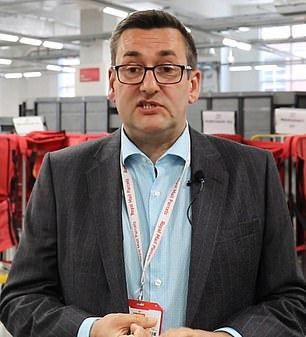Inside Royal Mail's super hub, the size of 30 football pitches, as it prepares for the final Christmas rush
Doing some last-minute Christmas shopping online is not without risk. But that's exactly what millions of Brits are doing this week – and hoping their presents arrive in time for the big day.
Some of the responsibility for this will fall on Royal Mail – with the postal service under intense pressure to perform better than last Christmas, when strikes caused chaos.
At the heart of Royal Mail's operations are its two parcel superhubs, huge warehouses in the Midlands and the North West that will handle a combined 2 million parcels a day over the festive period.
I visited the 53-hectare hub in Daventry which opened in June for a behind-the-scenes look at the busiest day of the year, December 11.
The first thing I notice is the size. The hub is the size of 30 football fields and the warehouse can fit 14 jumbo jets.
Cavernous: Royal Mail's super hub in Daventry, Northamptonshire, is the size of 30 football pitches and can accommodate 14 jumbo jets
It employs 700 permanent staff, but bosses have doubled the workforce to 1,400 over the festive period.
The atmosphere inside is quieter than I expected at such a busy time of year.
As the day progresses, tensions rise and strict deadlines arise, such as the mail train leaving every evening.
Trucks arrive loaded with packages that are unloaded onto large carts.
I see shipments from Footasylum and Dr. Martens arriving – shoes should be a popular gift this year.
The carts are fed to enormous robots, which tip the packages into the sorting machine.
Above my head, a huge conveyor belt rumbles, carrying a steady stream of brown boxes higher and higher into the building.
They are then automatically sorted by destination. The sorter takes 0.2 seconds to scan a barcode and does three at a time.
The equipment can even decipher written addresses within six seconds. The machine runs 21 hours a day, three of which are for essential maintenance. Everything about the superhub is designed to speed up package delivery.
Royal Mail chose the Northamptonshire location for its transport links and proximity to online retailers. Major customers such as Boohoo are located on the same industrial estate, meaning that when a customer places an order, the package arrives at Royal Mail in record time.

Royal Mail Chief Customer Officer Nick Landon
And faster deliveries are at the heart of Royal Mail's business plan as consumers have become more demanding.
We expect you to press a button and receive our goods within hours.
Royal Mail has also faced increasing competition from rivals such as delivery companies Evri and Yodel, and of course Amazon.
“This is one of my best sales tools,” Royal Mail Chief Customer Officer Nick Landon said of the hub.
But the shift has led to criticism that it gives priority to parcels while important letters such as NHS appointments languish in sorting offices.
The postal company denies that there is a central policy that attaches more importance to parcel delivery.
The company is responding to the increase in parcel volumes by investing in these hubs – and hopes to open at least two more in the coming years.
Royal Mail has a team of data scientists who try to predict what we will buy at different times of the year.
Ten years ago, the most popular time for online shopping was during the lunch break, but that has shifted to between 9 p.m. and 10 p.m.
The largest sector is clothing, and the largest group of shoppers are women in their late teens and early twenties.
“They tend to order based on what they saw on TV that night or what they saw their friends wearing, and that can lead to late-night orders for next-day delivery,” says Landon .
Royal Mail looked to competitors such as Amazon for inspiration when designing the super hubs, but also to less likely places.
Much of the equipment is made by the same companies that provide airports with logistics.
The requirements for sending mail and luggage are largely the same: packages and suitcases must both end up at the right destination.
Upstairs in the control room, employees look at a wall of screens with brightly colored diagrams that look a bit like a map of the London Underground.
Each illustration is a layer of the massive conveyor belt system I saw downstairs and flags issues such as a stuck package so they can be resolved as quickly as possible.
The machines process so many packages per minute that a short delay can have major consequences for delivery.
And the last thing Royal Mail needs is another Christmas full of disappointment.
Some links in this article may be affiliate links. If you click on it, we may earn a small commission. That helps us fund This Is Money and keep it free to use. We do not write articles to promote products. We do not allow a commercial relationship to compromise our editorial independence.
